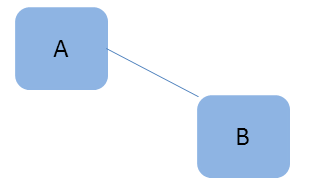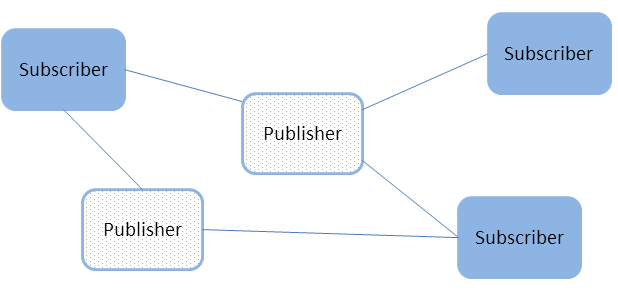Network Communications Models
The communications model underlying the network middleware is the most important factor in how applications communicate. The communications model impacts the performance, the ease to accomplish different communication transactions, the nature of detecting errors, and the robustness to different error conditions. Unfortunately, there is no “one size fits all” approach to distributed applications. Different communications models are better suited to handle different classes of application domains.
This section describes three main types of network communications models:
- Point-to-point
- Client-server
- Publish-subscribe
Point-to-point is the simplest form of communication, as illustrated in Figure 8. The telephone is an example of an everyday point-to-point communications device. To use a telephone, you must know the address (phone number) of the other party. Once a connection is established, you can have a reasonably high-bandwidth conversation. However, the telephone does not work as well if you have to talk to many people at the same time. The telephone is essentially one-to-one communication.
TCP is a point-to-point network protocol designed in the 1970s. While it provides reliable, high-bandwidth communication, TCP is cumbersome for systems with many communicating nodes.

Point-to-point is one-to-one communication.
To address the scalability issues of the Point-to-Point model, developers turned to the Client-Server model. Client-server networks designate one special server node that connects simultaneously to many client nodes, as illustrated in Figure 9.

Client-server is many-to-one communications.
Client-server is a "many-to-one" architecture. Ordering pizza over the phone is an example of client-server communication. Clients must know the phone number of the pizza parlor to place an order. The parlor can handle many orders without knowing ahead of time where people (clients) are located. After the order (request), the parlor asks the client where the response (pizza) should be sent. In the client-server model, each response is tied to a prior request. As a result, the response can be tailored to each request. In other words, each client makes a request (order) and each reply (pizza) is made for one specific client in mind.
The client-server network architecture works best when information is centralized, such as in databases, transaction processing systems, and file servers. However, if information is being generated at multiple nodes, a client-server architecture requires that all information are sent to the server for later redistribution to the clients. This approach is inefficient and precludes deterministic communications, since the client does not know when new information is available. The time between when the information is available on the server, and when the client asks and receives it adds a variable latency to the system.
Publish-subscribe model: In the publish-subscribe communications model (Figure 10), computer applications (nodes) “subscribe” to data they need and “publish” data they want to share. Messages pass directly between the publisher and the subscribers, rather than moving into and out of a centralized server. Most time-sensitive information intended to reach many people is sent by a publish-subscribe system. Examples of publish-subscribe systems in everyday life include television, magazines, and newspapers.
Publish-subscribe communication architectures are good for distributing large quantities of time-sensitive information efficiently, even in the presence of unreliable delivery mechanisms. This direct and simultaneous communication among a variety of nodes makes publish-subscribe network architecture the best choice for systems with complex time-critical data flows.
While the publish-subscribe model provides system architects with many advantages, it may not be the best choice for all types of communications, including:
- File-based transfers (alternate solution: FTP)
- Remote Method Invocation (alternate solutions: CORBA, COM, SOAP)
- Connection-based architectures (alternate solution: TCP/IP)
- Synchronous transfers (alternate solution: CORBA)

Publish-subscribe is many-to-many communications.
© 2015 RTI